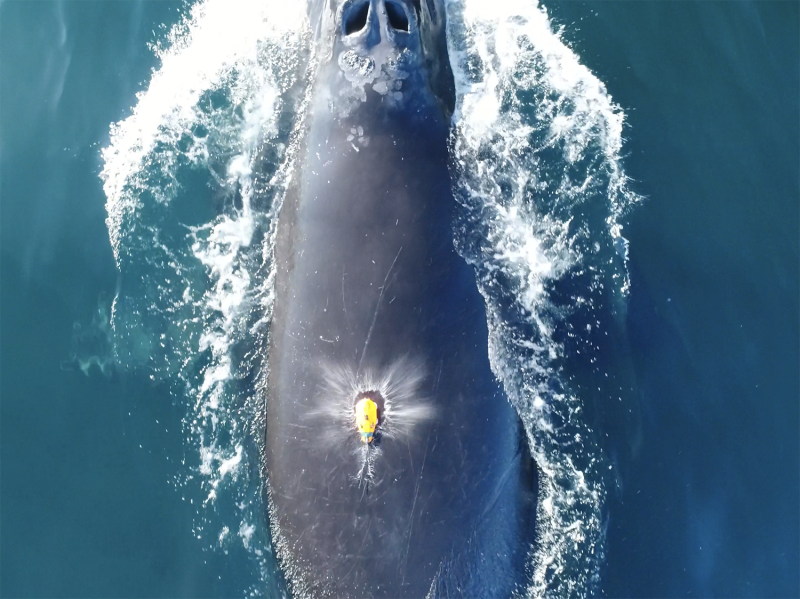On a recent NOAA Fisheries whale research cruise off New England, whale researcher Lisa Conger and her team tried a new twist on a developing field technique: using an uncrewed aerial system—a drone—to tag whales.
In this case the target was an endangered North Atlantic right whale, and Lisa was using a tag that sticks to the animal with suction cups. Two words that best describe the drone test: “Game changer,” said Conger. “Deploying tags using the drone has opened a lot of eyes and doors.”
Researchers have been testing drones to deploy suction cup tags on different species of whales around the world. In fact, colleagues at the nearby Stellwagen Bank National Marine Sanctuary have been testing this drone technique with sei whales for the past 2 years.
However, Conger’s cruise was the first to try using a drone to deploy suction-cup tags onto North Atlantic right whales. Typically, this kind of tagging is done from a small boat, with a human using a long pole with the tag attached to its end.
The drone operator uses height to ensure there is enough impact to get the tag to stick, something a human operator with a pole tag would adjust by feel. Using the drone, the vessel does not have to approach the animal as closely as it does when using traditional tagging, which can increase the opportunities for a successful deployment.
North Atlantic right whales are one of the world’s most endangered whales. Their population has been declining for more than a decade. We know much about threats caused by humans such as entanglement in fishing gear and collisions with ships. The kind of tag deployed on this cruise collects data that can tell us about an individual’s dive patterns, vocalization rates, and other behavior. This helps us piece together a fuller picture of biological and ecological factors contributing to the population decline.
This technology also has potential applications for attaching tags to entangled or otherwise compromised whales that would help emergency responders, while minimizing stress to the animal by reducing the number of close approaches.
Adverse Weather Leads to Tagging Success
On Conger’s cruise, the U.S. Coast Guard alerted the scientists about a large aggregation of North Atlantic right whales on Georges Bank. Nearly 70 of these whales, the largest group encountered during the 30-day cruise, were in the area when the scientists arrived. However, the weather was too rough to deploy the small boat to do any traditional on-water data collection near the animals, including tagging. Under normal circumstances, the team’s options for collecting useful data would have been very limited in these conditions.
“We need relatively good conditions to launch the small boat from the ship. We were not able to do this, eliminating our usual ability to attach a tag using a pole,” said Conger. “After some discussion, we decided to try launching the drone from the larger ship to attempt a tag deployment, and to our great excitement, it worked.”
Flying Into Whale Ecology
Ocean Alliance, a Gloucester, Massachusetts-based conservation organization, developed the drone-tagging technique. Ocean Alliance has been on the cutting edge of drone-based research for years. Two Ocean Alliance staff collaborated on this research expedition to pilot the tagging drone. The organization has the only team to have deployed more than 70 tags on six species of whales using a drone—a feat that requires both precision flying and a deep understanding of whale behavior.
“It’s exciting to have developed a system that works across multiple species and field environments and that is already proving to have a positive impact on the world of marine mammal research,” said Chris Zadra, drone program manager at Ocean Alliance
The drone operator would typically also operate from a small boat, closer to the whale. The attempts off the large research vessel entailed flying further and in windier conditions than usual. “The very accomplished drone pilot made all of the difference, no doubt,” said Conger. “We now know drone tagging can be deployed from a larger ship, from further away, in rougher weather than if we could only deploy tags from a smaller boat.”
“Ocean Alliance is proud to use our unique skill sets and newly developed methodologies to aid NOAA Fisheries in the understanding and recovery of this critically endangered species.” said Alicia Pensarosa, Ocean Alliance’s assistant director.
Conger is thrilled to support further development of this technology. “Working with the Ocean Alliance folks allowed us to see the possibilities first hand. These data are so difficult to collect and are urgently needed to help us understand how North Atlantic right whales are changing their habitat use and to support our efforts to recover this endangered species.”
Research and monitoring like that conducted during this cruise is part of a coast-wide effort to recover the North Atlantic right whale population. Conger’s work is shedding light on what is driving recent changes in when and where these animals aggregate during the year, and what they are doing while they are together.
North Atlantic right whales are federally protected under the federal Endangered Species Act and Marine Mammal Protection Act. This means that all research in U.S. waters on this species must be authorized under a NOAA Fisheries research permit.



